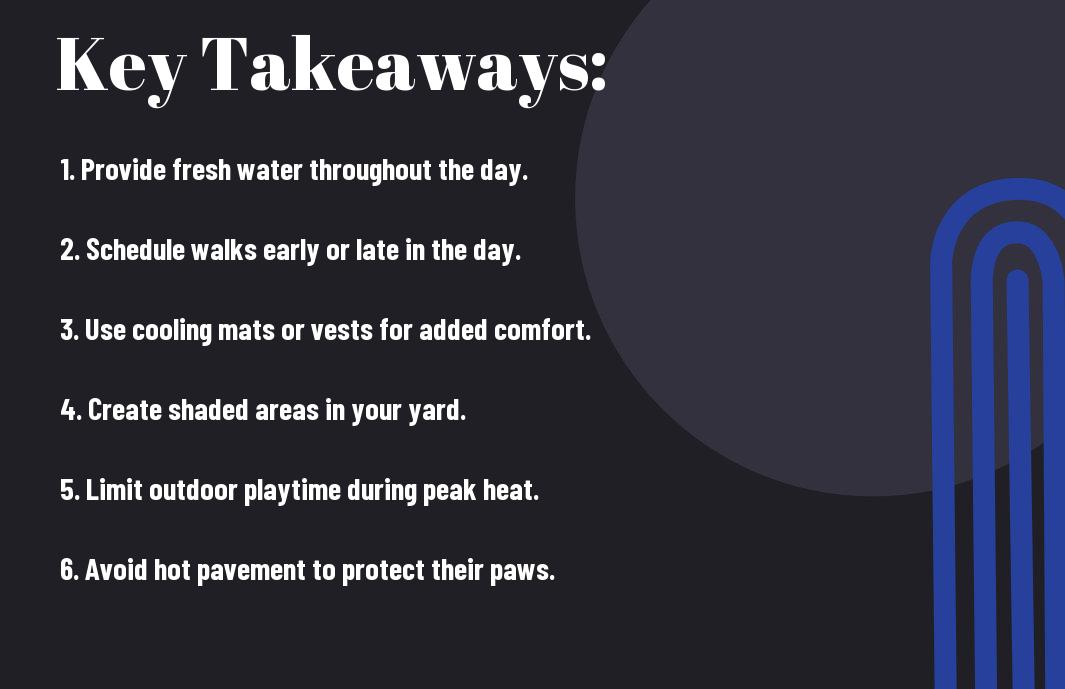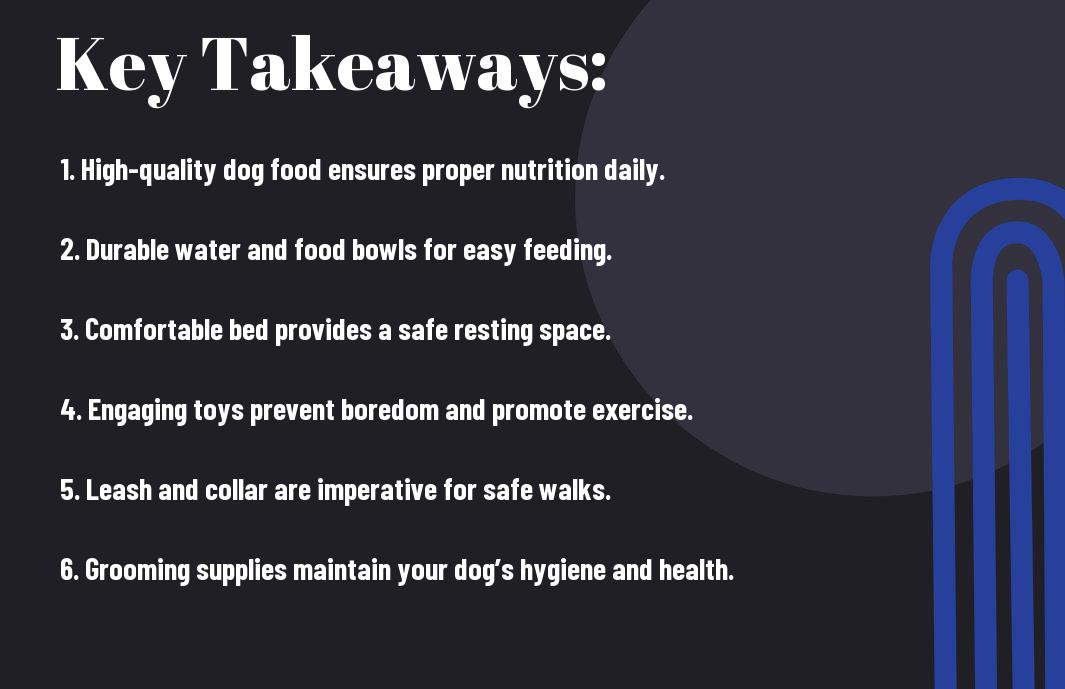With summer temperatures soaring, it’s vital to keep your dog safe and comfortable. High heat can lead to serious health issues, including heatstroke, which can be life-threatening for your furry friend. You can ensure your pet remains cool and hydrated by providing plenty of fresh water, creating shaded areas, and avoiding rigorous exercise during peak heat hours. In this guide, you’ll find practical tips to help you protect your dog from the summer heat while ensuring they enjoy the season to the fullest.


Understanding the Risks of Heat Stress
The summer months can pose serious risks to your dog’s health, particularly due to the potential for heat stress. When temperatures rise, dogs are at increased risk of overheating, which can lead to a variety of health issues if not addressed promptly. Understanding the signs and how to prevent heat stress is vital for keeping your canine companion safe during hot weather. Heat stress can cause a range of symptoms that can escalate quickly, making awareness imperative.
Symptoms of Heat Stress in Dogs
On a hot day, you might notice your dog exhibiting a few signs of heat stress. Common symptoms include excessive panting, drooling, and even lethargy. You may also observe your dog struggling to stand or lying down more than usual. In more severe cases, you might notice signs of confusion, a rapid heartbeat, or vomiting, which are indicative of a serious condition known as heat stroke. When these symptoms arise, immediate action is vital to ensure your dog’s safety.
Factors Affecting Heat Sensitivity
For every dog owner, it is important to be aware of the various factors that influence a dog’s heat sensitivity. Different breeds with varying fur thickness, body shape, and overall fitness levels can dictate how well your dog copes with high temperatures. For example, brachycephalic breeds, such as Bulldogs and Pugs, are particularly vulnerable due to their short noses, which makes it harder for them to regulate their body temperature effectively.
- Breed – Brachycephalic breeds are at higher risk.
- Age – Puppies and older dogs may struggle more.
- Weight – Overweight dogs are less heat tolerant.
- Fitness Level – Active dogs may have different heat responses.
Hence, being aware of how these factors apply to your dog can help you take the necessary precautions when the temperature rises. Monitoring your dog’s exertion level during playtime and understanding their individual health conditions can significantly reduce the risk of heat-related issues. Each dog is unique, so adapt your summer activities accordingly to avoid the dangers associated with overheating.
- Individual Health Conditions – Some dogs may have pre-existing issues.
- Environment – Outdoor conditions and humidity add to heat stress.
- Hydration – Ensure your dog has access to fresh water.
Knowing how various factors influence your dog’s response to heat will enable you to take appropriate measures for a safer summer experience. Keep a close eye on your dog’s behavior, and don’t hesitate to seek veterinary help if you observe any signs of heat stress.
Hydration is Key
Even during the hottest months of the year, it is vital to ensure that your dog stays well-hydrated. Just like humans, dogs can suffer from dehydration, which can lead to serious health issues. As temperatures rise, your furry friend will need more fluid intake to help regulate their body temperature and maintain optimal health. Providing ample access to fresh, clean water is an imperative step in keeping your pup comfortable and safe throughout the summer.
Importance of Fresh Water
For your dog’s overall well-being, the availability of fresh water cannot be overstated. Water helps in various bodily functions, including digestion, circulation, and temperature regulation. When temperatures soar, dehydration can set in more rapidly, leading to symptoms like lethargy, excessive panting, and dry gums. Having fresh water at their disposal can help prevent these issues and keep your dog feeling energetic and playful during outdoor activities.
Tips for Encouraging Water Intake
The way you present water can significantly affect your dog’s water consumption. Here are some effective tips to encourage them to drink more:
- Provide multiple bowls in different locations around your house and yard.
- Use a pet-friendly water fountain to entice them with the sound and movement of flowing water.
- Keep the water bowl clean and filled with fresh water, changing it at least twice a day.
- Add ice cubes or a splash of low-sodium broth to make water more appealing.
After implementing these suggestions, you may notice a marked increase in your dog’s hydration levels.
You can also explore various methods to encourage your dog to drink more water throughout the day. For example, incorporating water-rich foods such as watermelon or cucumber into their diet can enhance their hydration. Additionally, offering rewards or praise when your dog drinks can create a positive association with hydration, reinforcing the behavior over time.
- Serve water-rich foods alongside regular meals.
- Engage in interactive and fun activities that involve water.
- Consider using a pet water bottle on walks and during playdates.
After adopting these strategies, you should observe a noticeable improvement in your dog’s water intake.
Frozen Treat Ideas
Treat your furry friend to some delicious frozen treats this summer! Not only do frozen treats offer a refreshing way to cool down, but they also provide additional hydration. You can easily make your own frozen snacks using your dog’s favorite ingredients, such as yogurt, peanut butter, or pureed fruits. Just make sure to avoid any toxic foods like grapes and xylitol, which can be harmful to your pet.
For instance, you can create dog-friendly popsicles by blending together plain yogurt and bananas, then pouring the mixture into ice cube trays. After freezing the treats, your dog will be delighted when they get to enjoy a cool, refreshing snack on a hot day. Additionally, you can add in chopped carrots or blueberries for extra flavor and nutrition.
Creating a Cool Environment
All pet owners should be proactive in ensuring their furry friends remain comfortable during the sweltering summer months. By creating a cool environment for your dog, you can help prevent overheating, which can pose serious health risks. This involves both indoor and outdoor considerations that can significantly enhance your dog’s summer experience.
Indoor Cooling Solutions
Any dog owner can adopt various indoor cooling solutions to keep their home environment comfortable for their pet. Investing in a fan or utilizing air conditioning can help maintain a lower temperature inside your home. Make sure your dog has access to shaded spots, particularly near windows where sunlight streams in. Agile pets may also enjoy lying on cool tile or hardwood floors rather than carpeting, as these surfaces tend to stay cooler.
Additionally, be sure to provide plenty of fresh, cool water for your dog. A dehydrated dog is more susceptible to heat-related issues. You can even consider using a pet-safe cooling mat, which absorbs heat and provides a refreshing place for your dog to relax. Lastly, you might play soothing music or leave the curtains drawn to help keep the sun’s rays from heating up your indoor space.
Outdoor Shade Options
Around your backyard or at the park, it’s crucial to ensure that your dog has access to ample shade. This can be as simple as setting up a canopy, using umbrellas, or finding natural shade under trees. Establishing a shaded area for your dog to retreat to will help prevent overheating when they are outdoors. Additionally, you can create a shaded dog house or use outdoor furniture to craft a cozy spot away from the direct sun.
Even a few moments under the sun without sufficient cover can lead to distress for your dog, so be mindful of their outdoor activities. Check the temperature of the ground if your dog likes to lay down; surfaces like asphalt can burn their paws and contribute to overheating. Keeping your dog cool outdoors is not just about shade; it’s about being proactive in ensuring their comfort and safety.
Hot Weather Gear for Dogs
Across the range of solutions available, investing in proper hot weather gear for your dog can provide an additional layer of protection from the heat. Options like cooling vests, bandanas, or even specialized harnesses can help regulate your dog’s body temperature during those sweltering days. These items work by using evaporative cooling technology or water to help keep your pet comfortable as they engage in their favorite outdoor activities.
Considering the age and health of your dog, the right gear can be especially beneficial for breeds that are more prone to overheating. Dogs that are older, overweight, or have short snouts may struggle more in hot weather and will greatly benefit from protective gear. Always prioritize your dog’s comfort by adjusting their outdoor activities to the temperature, and when in doubt, opt for indoor playtime on particularly hot days.
Exercise and Activity Adjustments
Despite the joy that comes from spending time outdoors with your dog during the summer months, it is crucial to adjust your exercise routine to protect your furry friend from overheating. High temperatures can pose significant risks to your dog, including heat exhaustion and even heatstroke. To keep your dog safe and healthy, you need to be strategic about when and how you exercise together.
Best Times for Walks
By planning your walks during the early morning or late evening, you can avoid the peak heat of the day. This not only keeps your dog cooler but also makes the walk more enjoyable for both of you. The pavement and grass are also cooler during these times, reducing the risk of paw pad burns that can occur on hot surfaces. If you must walk during the day, try to stick to shaded areas where the temperature is more tolerable.
In addition to timing, pay attention to your dog’s signals. If they start to lag behind, pant excessively, or seek shade, it’s time to cut the walk short. Your dog’s well-being should always come first, and adjusting the timing of your outdoor activities is a simple yet effective way to ensure they stay comfortable during the summer heat.
Cooling Down After Exercise
Activity that takes place outside can heat your dog up quickly, so it’s crucial to establish a proper cooling-down routine. After your walks or playtime, offer your dog plenty of fresh water to hydrate and help lower their body temperature. Additionally, you can use a damp towel to wipe down their body, especially around the neck, belly, and paws—areas that can significantly impact their cooling process.
And don’t forget to provide a cool, shaded spot for your dog to relax after exercising. A fan or air-conditioned space can help bring their body temperature down faster. Avoid taking your dog on strenuous activities when temperatures exceed 80°F (27°C) to mitigate heat-related issues effectively.
Alternative Indoor Activities
Above all, when summer temperatures become too intense, consider engaging in alternative indoor activities to keep your dog stimulated. Interactive toys, such as puzzle feeders, can provide mental exercise while keeping them cool at the same time. You can also set up an indoor agility course with obstacles made from household items, giving your dog the chance to have some fun without the heat.
Exercise indoors not only keeps your dog safe from hot weather but also helps maintain their physical fitness and mental sharpness. Activities like tug-of-war and hide-and-seek can be equally stimulating and encourage bonding time, so don’t hesitate to get creative and find what your dog enjoys most.
Exercise your options for indoor fun, and you might just find that these activities are as enjoyable for your dog as a walk in the sun!
Grooming Tips for Summer
Now, as the summer heats up, it’s time for you to pay attention to your dog’s grooming needs. Keeping your pet’s coat well-maintained can significantly help in regulating their body temperature and preventing overheating. Here are some necessary grooming tips to keep your furry friend feeling fresh and cool:
- Regular brushing to prevent matting and promote airflow through the coat
- Consider a summer trim, especially for long-haired breeds
- Bathing your dog with cool water to clean and refresh their skin
- Using dog-safe cooling sprays or conditioners
- Checking and cleaning ears regularly to prevent infections
The Role of Coat and Fur Type
An important aspect of grooming your dog in the summer is understanding the impact of their coat and fur type on their ability to stay cool. Dogs have different types of coats, which can range from short and fine to long and thick. For example, double-coated breeds such as Golden Retrievers can trap heat beneath their undercoat, making them more susceptible to overheating. Regular brushing of these coats helps to remove the undercoat and allows better airflow, which is necessary for keeping your dog cool.
On the other hand, short-haired breeds like Beagles or Boxers may not require as much grooming, but they still benefit from regular brushing to maintain a healthy coat. It’s also good to know that some dog coats actually provide insulation against heat, so shaving your dog may not always be the best option. You should consult with your veterinarian or a professional groomer to understand the best practices for your specific dog’s coat type.
Recommended Summer Grooming Practices
Summer is the ideal season to ramp up your grooming routine. A fresh summer trim can help to reduce the amount of fur that your dog carries, making it easier for them to regulate their body temperature. Additionally, you should aim to brush your dog several times a week, as this will help remove debris and dead fur, allowing their skin to breathe better. Opt for products that are designed for hot weather, such as cooling shampoos that hydrate and soothe your dog’s skin.
Further, consider investing in grooming tools that are designed specifically for the summer months, such as deshedding tools or cooling brushes. These tools can help prevent excessive shedding and reduce the risk of matting, which can trap heat. Additionally, taking the time to regularly check and maintain your dog’s nails will help them avoid discomfort when walking on hot pavement.
Keeping Paws Cool
Grooming doesn’t stop at your dog’s fur; taking care of their paws is equally important during the summer. Heat can build up in their paw pads, making it uncomfortable for your dog to walk on hot surfaces. You should always check your dog’s paws for signs of burns or irritation after walks on pavement or sand. Keeping the fur between their pads trimmed can also help prevent them from collecting heat.
Keeping your dog’s paws cool can be as simple as providing them with a shady spot to rest in or using specialized paw wax that protects their pads from the heat. Ensure that you take breaks during walks in the heat of the day, and consider using protective booties if your dog is more sensitive to hot surfaces. This will not only make your dog more comfortable but also contribute to their overall summer wellbeing.

Traveling with Your Dog in Summer
For many pet owners, summer is the perfect time to hit the road with your furry friend. However, it’s important to be aware of the challenges and safety concerns that come with traveling in warmer weather. You want your dog to have as positive an experience as you do, so planning ahead will ensure a fun and safe trip for both of you.
Safety Precautions for Road Trips
At the outset of your journey, make sure to keep your dog secured in the vehicle. A properly fitted dog seatbelt or a secure crate can prevent distractions while you’re driving and help to protect your pet in the event of an accident. Additionally, it’s important to never leave your dog alone in a parked car, even for a short period. The inside of a car can heat up quickly, leading to heatstroke or even death within minutes. Monitor the temperature and stops to allow your dog to stretch their legs and hydrate, ensuring they’re always comfortable.
Another key consideration is your dog’s health during long drives. At each stop, check for signs of overheating—panting, drooling, or lethargy can indicate that your dog is too hot. Always have water available, and if temperatures soar, consider adjusting your travel schedule to avoid the hottest parts of the day.
Pet-Friendly Travel Essentials
An important component of traveling with your dog is packing all the necessary supplies to keep them happy and healthy. Some must-have items include a durable travel bowl for food and water, their favorite toys for comfort, and a first-aid kit designed specifically for pets. Don’t overlook grooming supplies to manage shedding, as well as dog-friendly sunscreen if your dog has short hair or light skin. A familiar blanket or bed can also help your dog feel secure in unfamiliar environments.
Understanding what your dog needs while traveling will allow you to have a smoother trip. Make a checklist of all items to ensure that you’re never caught unprepared. Bringing along extra food, medication, and any other importants will provide you with peace of mind while on your adventure.
Acclimating Your Dog to New Environments
To make your travel experiences enjoyable, it’s important to acclimate your dog to new surroundings gradually. This can involve taking them for short trips to various destinations such as parks or friends’ homes, allowing them to explore and adjust to different stimuli. When you arrive at a new location, allow your dog to take their time to sniff around and get comfortable with the area. Always keep an eye on their behavior, as some dogs can become anxious in unfamiliar settings.
Environments can have various sounds, smells, and sights that might be overwhelming for your dog. Try to introduce them to these new experiences in a calm manner, offering praise and treats for good behavior. Creating a routine during your travels can make a big difference, making them feel secure in the midst of all the changes. By taking it slow and being observant, you can foster a positive experience that your dog will enjoy.
Conclusion
Drawing together the various strategies for keeping your dog cool in the summer, it is necessary to be proactive in managing their comfort in hot weather. Providing ample shade and fresh water is a fundamental step, ensuring that your furry friend has a safe place to rest. You can also consider adjusting your outdoor activities to cooler times of the day, allowing for enjoyable yet safe play. Utilizing tools like cooling mats or vests can further enhance your dog’s comfort during the sweltering months.
Ultimately, your awareness and attentiveness to your dog’s needs are key to their well-being in the heat. Regular check-ins on their condition while outdoors, alongside a consistent hydration routine, will help you ensure they remain happy and healthy. By implementing these tips, you not only protect your dog from overheating but also foster a joyful summer experience for both of you.
Q: What are some effective ways to keep my dog cool during hot summer days?
A: There are several strategies to help keep your dog cool when temperatures rise. First, ensure that they have access to plenty of fresh, cool water at all times. You can also provide shade in outdoor areas, such as a shaded spot under a tree or a dog house designed for ventilation. Furthermore, consider limiting outdoor activities to the cooler parts of the day, such as early morning or late evening. Keeping your dog’s coat well-groomed can help as well; brushing can remove excess fur that can trap heat.
Q: Are there any signs that indicate my dog is overheating?
A: Yes, there are several signs that your dog may be overheating. Look for excessive panting, drooling, or a rapid heartbeat. You might also notice your dog being lethargic, having trouble standing or walking, or displaying signs of distress. In severe cases, overheating can lead to heatstroke, which can manifest as vomiting, a body temperature over 104°F, or even loss of consciousness. If you observe any of these symptoms, it’s important to cool them down immediately and consult a veterinarian.
Q: Can I use any specific products to help cool my dog off?
A: Yes, there are various products designed specifically to help dogs stay cool in hot weather. Cooling vests or bandanas can be soaked in cool water and then placed on your dog. These products work by evaporative cooling, which can significantly lower your dog’s body temperature. Additionally, there are also cooling mats that you can place in areas where your dog rests. These mats absorb heat and provide a cool surface for your pet. Make sure to always supervise your dog when using such products to ensure their safety and comfort.










